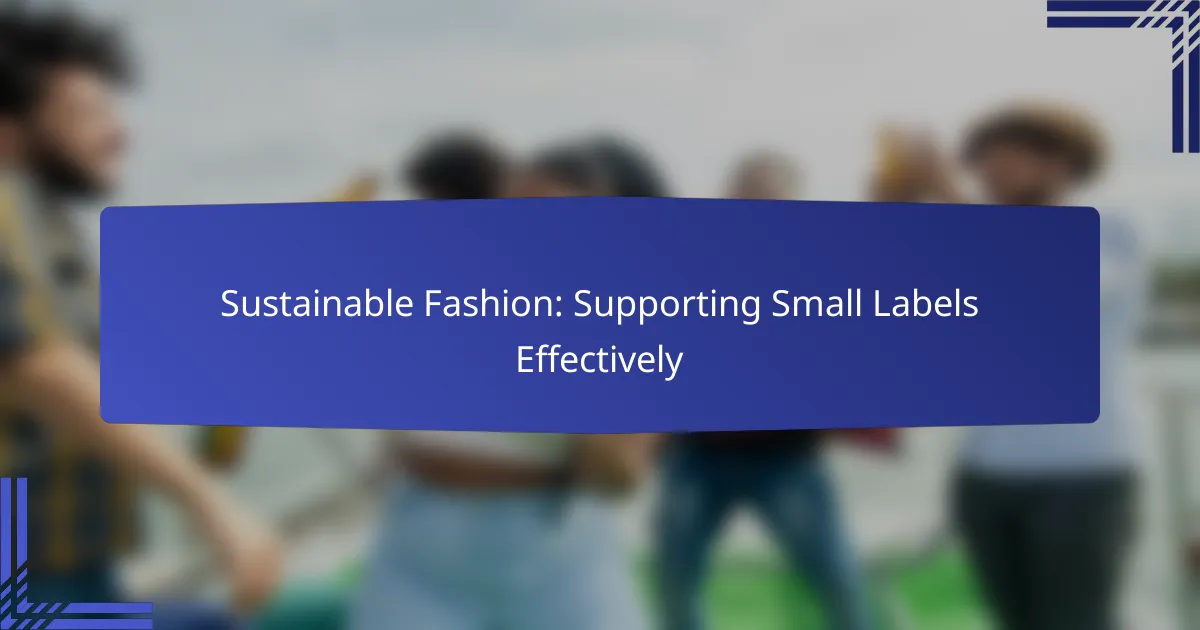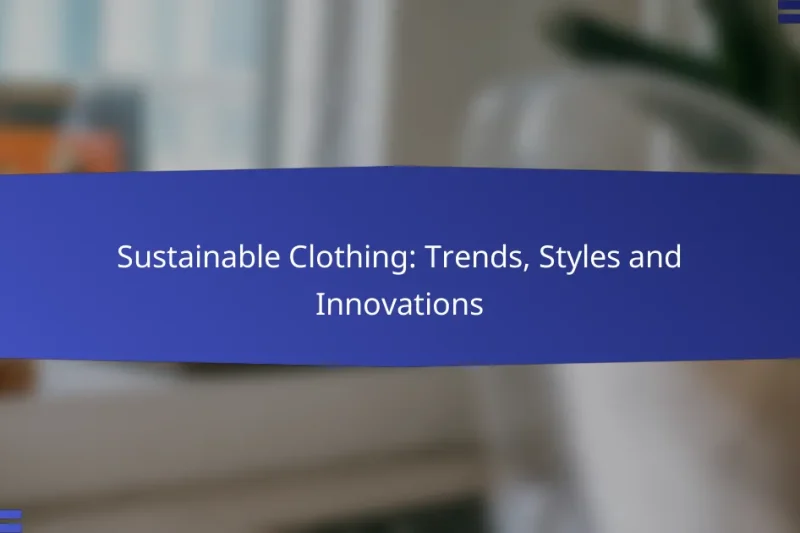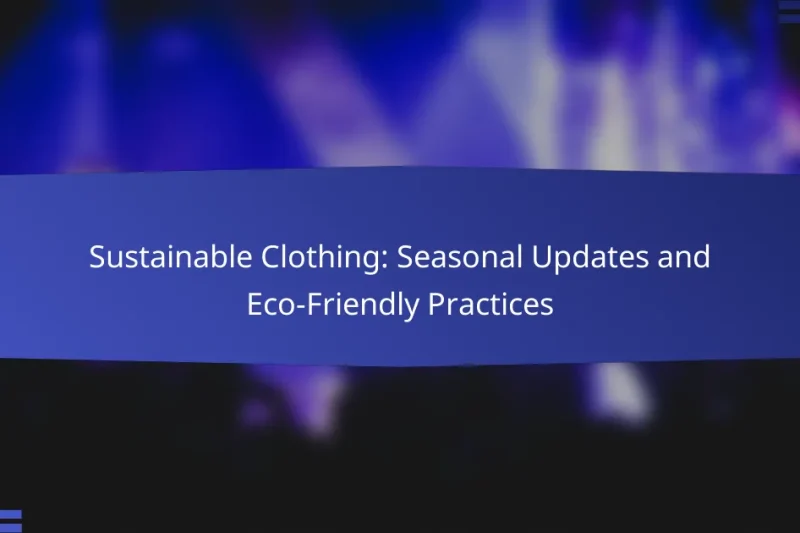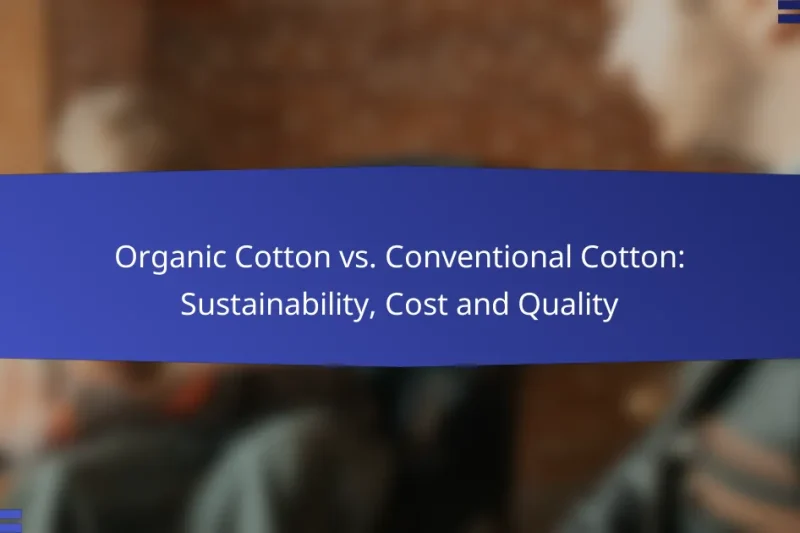As consumer mindsets evolve, there is a notable shift towards sustainable fashion driven by heightened awareness … Consumer Mindsets: Shifts, Awareness and Sustainable FashionRead more
Sustainable clothing is an essential choice for those looking to minimize their environmental impact while supporting ethical labor practices. By opting for brands that prioritize transparency and use eco-friendly materials, consumers can make informed decisions that benefit both the planet and the people who make our clothes. This guide will help you navigate the world of sustainable fashion, highlighting key practices and top brands committed to a more responsible approach to clothing.
Sustainable Clothing: Trends, Styles and Innovations
Sustainable clothing is rapidly gaining traction as consumers increasingly seek eco-friendly materials and ethical production methods. … Sustainable Clothing: Trends, Styles and InnovationsRead more
Sustainable Fashion: Supporting Small Labels Effectively
Supporting small sustainable fashion labels is a powerful way to promote ethical practices while enhancing local … Sustainable Fashion: Supporting Small Labels EffectivelyRead more
Social Media’s Influence: Trends, Engagement and Purchases
Social media plays a crucial role in shaping consumer behavior and influencing purchasing decisions in today’s … Social Media’s Influence: Trends, Engagement and PurchasesRead more
Sustainable Clothing: Upcycling Benefits and Eco-Friendly Choices
Sustainable clothing is gaining traction as consumers seek to minimize their environmental impact through eco-friendly choices. … Sustainable Clothing: Upcycling Benefits and Eco-Friendly ChoicesRead more
Sustainable Clothing: Seasonal Updates and Eco-Friendly Practices
Sustainable clothing is an essential choice for environmentally conscious consumers, emphasizing eco-friendly practices and ethical labor. … Sustainable Clothing: Seasonal Updates and Eco-Friendly PracticesRead more
Organic Cotton vs. Conventional Cotton: Sustainability, Cost and Quality
Organic cotton stands out as a more sustainable alternative to conventional cotton, thanks to its environmentally … Organic Cotton vs. Conventional Cotton: Sustainability, Cost and QualityRead more
Sustainable Fashion: Brand Storytelling and Marketing Role
Sustainable fashion brands are redefining the industry by emphasizing authenticity and transparency in their storytelling. By … Sustainable Fashion: Brand Storytelling and Marketing RoleRead more
Sustainable Fabrics: Washing Techniques, Lifespan Extension and Care
Proper care and washing techniques are crucial for maintaining the quality and longevity of sustainable fabrics … Sustainable Fabrics: Washing Techniques, Lifespan Extension and CareRead more
Sustainable Fashion: Local vs. Global Brand Impact
The debate between local and global sustainable fashion brands highlights distinct approaches to reducing environmental impact. … Sustainable Fashion: Local vs. Global Brand ImpactRead more
What are the benefits of sustainable clothing?
Sustainable clothing offers numerous benefits, including reduced environmental impact, improved worker conditions, and long-term cost savings. By choosing sustainable options, consumers can contribute to a healthier planet and support ethical labor practices.
Environmental impact reduction
Sustainable clothing significantly reduces environmental harm through the use of eco-friendly materials and production methods. For instance, organic cotton requires less water and avoids harmful pesticides, while recycled fabrics help minimize waste in landfills.
Additionally, sustainable brands often implement energy-efficient practices and reduce carbon emissions during manufacturing. This collective effort contributes to a smaller ecological footprint and promotes biodiversity.
Improved worker conditions
Choosing sustainable clothing often means supporting brands that prioritize fair labor practices. These companies typically provide safe working environments, fair wages, and reasonable working hours for their employees.
By investing in ethical brands, consumers can help combat exploitation in the fashion industry. Many sustainable labels are transparent about their supply chains, allowing shoppers to make informed choices that support better conditions for workers.
Long-term cost savings
While sustainable clothing may have a higher upfront cost, it often leads to long-term savings. High-quality, durable materials mean that these garments last longer, reducing the need for frequent replacements.
Moreover, investing in sustainable fashion can be more economical over time. Consumers can save money by purchasing fewer items that are versatile and timeless, rather than fast fashion pieces that quickly go out of style.
How to choose sustainable clothing brands?
Choosing sustainable clothing brands involves evaluating their practices and commitments to environmental and social responsibility. Focus on certifications, transparency, and material sourcing to make informed decisions.
Look for certifications
Certifications can indicate a brand's commitment to sustainability. Look for labels like GOTS (Global Organic Textile Standard), OEKO-TEX, and Fair Trade, which ensure certain environmental and social criteria are met.
Brands with these certifications often undergo regular audits and must adhere to strict guidelines. This adds a layer of trust, as you can be more confident in their sustainable practices.
Research brand transparency
Transparency is crucial when assessing sustainable clothing brands. Brands that openly share their supply chain practices, production processes, and labor conditions are more likely to be genuinely committed to sustainability.
Check their websites for detailed information about sourcing, manufacturing, and labor policies. Brands that publish sustainability reports or engage in third-party assessments demonstrate a higher level of accountability.
Evaluate material sourcing
Material sourcing plays a significant role in sustainability. Look for brands that use organic, recycled, or upcycled materials, as these options typically have a lower environmental impact compared to conventional fabrics.
Consider the lifecycle of the materials used. For instance, organic cotton and Tencel are often more sustainable choices than synthetic fibers. Understanding the origins and processing of materials can help you choose brands that prioritize eco-friendly practices.
What are the best sustainable clothing brands in the US?
The best sustainable clothing brands in the US focus on environmentally friendly practices, ethical labor standards, and high-quality materials. These brands prioritize transparency and often utilize recycled or organic materials in their production processes.
Patagonia
Patagonia is renowned for its commitment to environmental sustainability and ethical manufacturing. The brand uses organic cotton, recycled polyester, and other eco-friendly materials in its products.
Additionally, Patagonia encourages customers to repair their clothing through its Worn Wear program, promoting a circular economy. This initiative helps reduce waste and extends the life of garments.
Eileen Fisher
Eileen Fisher emphasizes simplicity and sustainability in its designs, focusing on timeless pieces made from organic and recycled fibers. The brand is committed to fair labor practices and transparency in its supply chain.
Through its Renew program, Eileen Fisher takes back worn garments to be refurbished or recycled, reducing landfill waste. This approach not only supports sustainability but also encourages responsible consumer behavior.
Everlane
Everlane is known for its "Radical Transparency" policy, which provides customers with detailed information about pricing, factories, and materials. The brand uses sustainable materials such as TENCEL and recycled polyester in its clothing lines.
Everlane also focuses on ethical manufacturing, partnering with factories that meet high standards for labor practices. This commitment ensures that workers are treated fairly while producing quality garments.
How does sustainable clothing compare to fast fashion?
Sustainable clothing prioritizes quality, ethical production, and environmental responsibility, contrasting sharply with fast fashion's focus on low-cost, high-volume production. While fast fashion often leads to waste and exploitation, sustainable options aim to minimize their impact on both people and the planet.
Quality and durability
Sustainable clothing typically emphasizes higher quality and durability compared to fast fashion items. These garments are often made from better materials and crafted with attention to detail, resulting in longer-lasting wear. Investing in sustainable pieces can reduce the frequency of replacements, ultimately saving money over time.
For example, a well-made organic cotton shirt may last several years, while a similar fast fashion shirt might only endure a few washes before showing signs of wear. This durability is a key factor in evaluating clothing sustainability.
Environmental footprint
The environmental footprint of sustainable clothing is significantly lower than that of fast fashion. Sustainable brands often use eco-friendly materials, such as organic cotton or recycled fabrics, which require less water and energy to produce. Additionally, sustainable practices include minimizing waste and reducing carbon emissions throughout the supply chain.
Fast fashion, on the other hand, contributes to pollution and resource depletion. For instance, the production of synthetic fibers can release harmful chemicals into waterways, while the rapid turnover of styles leads to massive textile waste in landfills. Choosing sustainable options helps mitigate these environmental impacts.
Ethical labor practices
Sustainable clothing brands prioritize ethical labor practices, ensuring fair wages and safe working conditions for their employees. Many sustainable companies are transparent about their supply chains and adhere to certifications that promote ethical labor standards, such as Fair Trade or GOTS (Global Organic Textile Standard).
In contrast, fast fashion often relies on exploitative labor practices, with workers in developing countries facing low pay and poor working conditions. By supporting sustainable brands, consumers can contribute to a more equitable fashion industry and promote better treatment of workers worldwide.
What materials are used in sustainable clothing?
Sustainable clothing primarily utilizes eco-friendly materials that minimize environmental impact. Common options include organic cotton, recycled polyester, and Tencel, each offering unique benefits and considerations for consumers.
Organic cotton
Organic cotton is grown without synthetic pesticides or fertilizers, making it a healthier choice for the environment and farmers. This material often requires less water compared to conventional cotton, which can significantly reduce water usage in agriculture.
When purchasing organic cotton clothing, look for certifications such as GOTS (Global Organic Textile Standard) to ensure the product meets strict environmental and social criteria. Brands may vary in their commitment to sustainability, so researching the company’s practices is beneficial.
Recycled polyester
Recycled polyester is made from post-consumer plastic waste, such as water bottles, which helps divert materials from landfills. This process not only reduces the need for virgin polyester production but also lowers energy consumption and greenhouse gas emissions.
When choosing recycled polyester garments, check for labels indicating the percentage of recycled content. Higher percentages typically signify a more sustainable product. Additionally, be aware that while recycled polyester is durable, it can shed microplastics during washing, so using a Guppyfriend bag or similar product can help mitigate this issue.
Tencel
Tencel, or lyocell, is derived from sustainably sourced wood pulp, primarily from eucalyptus trees. The production process uses a closed-loop system that recycles water and solvents, resulting in minimal environmental impact. Tencel is known for its softness and breathability, making it a popular choice for comfortable clothing.
When selecting Tencel clothing, look for certifications like OEKO-TEX, which ensures the absence of harmful substances. Tencel is biodegradable, adding to its appeal as a sustainable option. However, consider the care instructions, as some Tencel garments may require gentle washing to maintain their quality.
What are the challenges of sustainable clothing?
Sustainable clothing faces several challenges, including higher upfront costs, limited availability, and consumer awareness. These factors can impact both manufacturers and buyers, making it essential to understand the implications of choosing sustainable options.
Higher upfront costs
One of the primary challenges of sustainable clothing is the higher upfront costs associated with eco-friendly materials and ethical production practices. Sustainable fabrics, such as organic cotton or Tencel, often come at a premium compared to conventional materials.
For consumers, this means spending more initially, which can be a deterrent. However, sustainable clothing is typically more durable and may save money in the long run due to less frequent replacements. It's important to weigh the initial investment against potential long-term savings.
When shopping for sustainable options, look for sales or second-hand items to mitigate costs. Consider brands that offer transparent pricing and explain how their practices contribute to sustainability, helping you make informed purchasing decisions.














